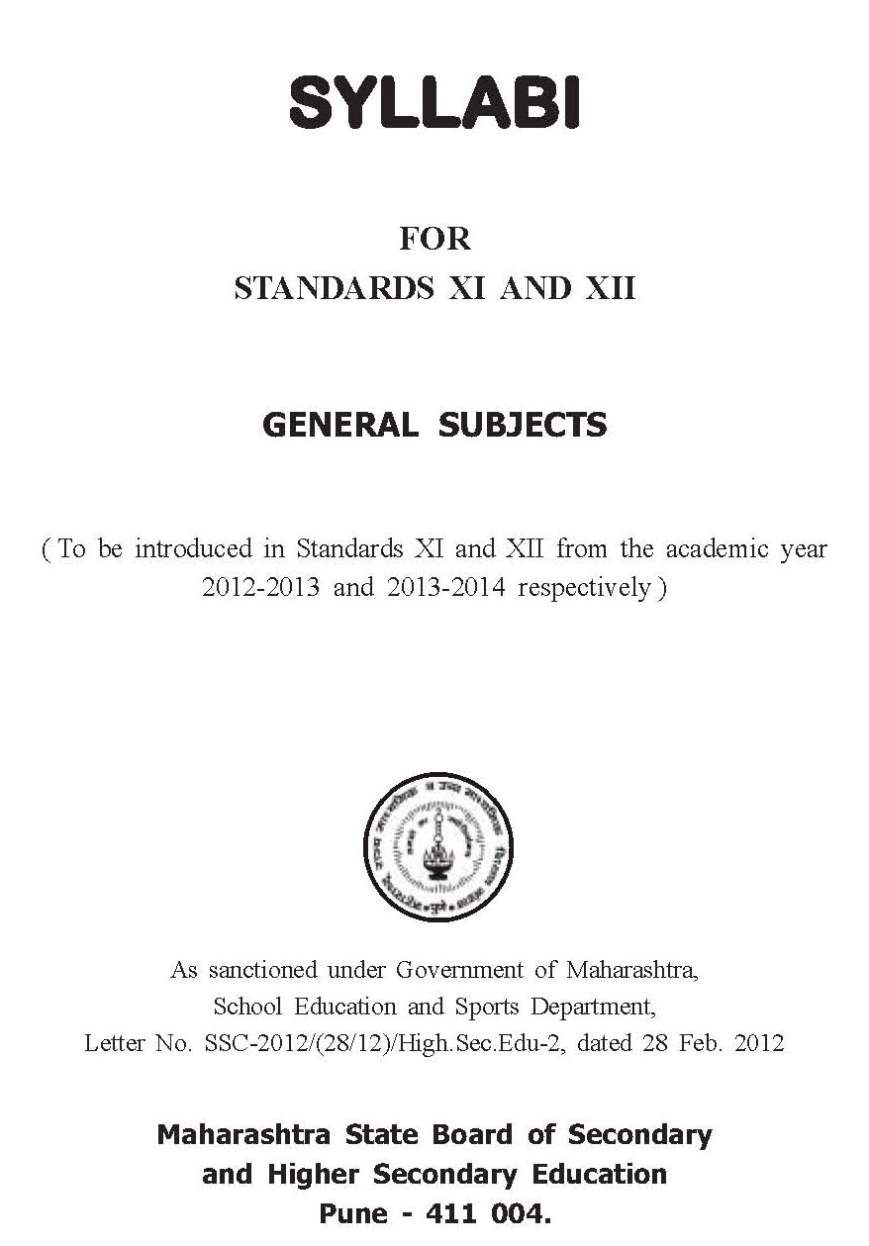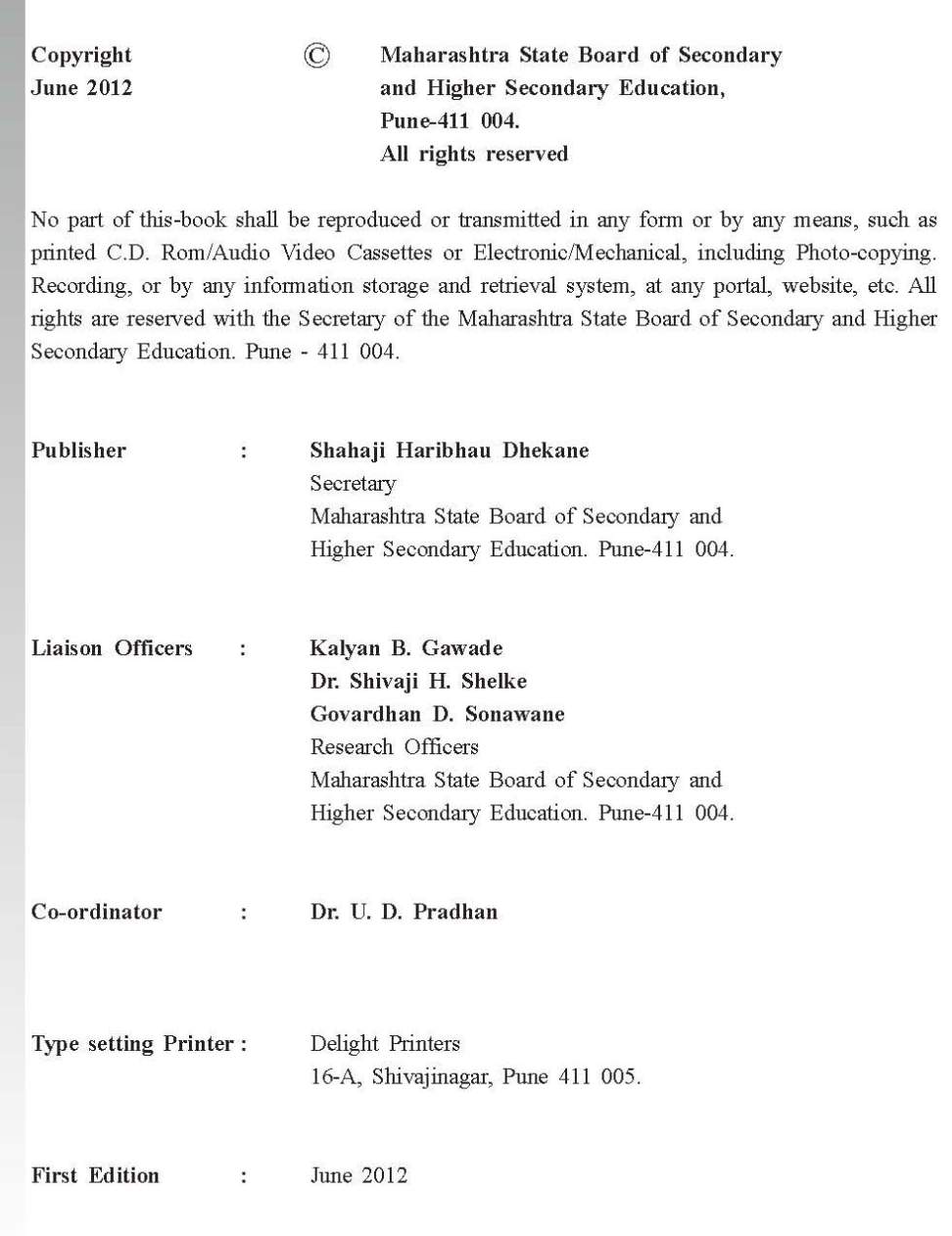| Re: HSC 12th Syllabus of Maharashtra Board Of Education
The syllabus of Class 12th Biology of Maharashtra State Board of Secondary & Higher Secondary Education, Pune is as follows:
Biology HSC Syllabus Maharashtra HSC Board
Biology Class 12th
Introduction
Higher secondary is the most crucial stage of education because at this juncture specialized disciplines of science are introduced. The present syllabus reinforces the concepts introduced in lower classes. Recently, the science of biology has undergone a paradigm shift that has transformed it from a collection of loosely related facts into a modern applied science.
Living organisms exhibit extremely complex functional system. Organisms seldom occur as isolated individuals. They are organized into populations and biological communities. Organisms, communities, ecosystems and environment constitute unique set of natural resources of great importance. Knowledge of biology helps us to understand a common thread which holds all these components together. Understanding of biology will help in the sustainable development of the environment and will also ensure the existence of earth with all its amazing diversity.
This syllabus is designed to prepare students for various examinations conducted at state and national level. Hence it has been prepared in accordance with the guidelines shown in the final version of common core syllabi of COBSE, Delhi. Accordingly some additional topics from state Board syllabus have been deleted whereas the lacking topics have been added. The entire unit Ecology and Environment has now been added under Botany and Zoology sections.
Objectives
The prescribed syllabus is expected to
Promote the inherent skill of observation.
Assist to understand the underlying principles of biological sciences and thereby develop scientific attitude towards biological phenomena.
Help students to understand the functioning of organisms.
Make students aware of issues of global importance.
Guide students to perform easy experiments for better understanding of biological principles and to develop experimental skills required in practical work.
Create awareness about the contribution of biology to human welfare
Section I BOTANY
Unit 1: Genetics and Evolution:
Chapter 1 Genetic Basis of Inheritance:
Mendelian inheritance. Deviations from Mendelian ratio (gene interaction-incomplete dominance, co-dominance, multiple alleles and Inheritance of blood groups), Pleiotropy, Elementary idea of polygenic inheritance.
Chapter 2 Gene: its nature, expression and regulation:
Modern concept of gene in brief-cistron, muton and recon.
DNA as genetic material, structure of DNA as given by Watson and Cricks model, DNA.
Packaging, semi conservative replication of eukaryotic DNA
RNA: General structure types and functions.
Protein Synthesis; central dogma, Transcription; Translation-Genetic Code, Gene Expression and Gene Regulation (The Lac operon as a typical model of gene regulation)
Unit 2: Biotechnology and its application:
Chapter 3 Biotechnology: Process and Application :
Genetic engineering (Recombinant DNA technology):
Transposons, Plasmids, Bacteriophages;
Producing Restriction Fragments, Preparing and cloning a DNA Library,
Gene Amplification (PCR). Application of Biotechnology in Agriculture BT crops Biosafety Issues (Biopiracy and patents)
Unit 3: Biology and Human Welfare:
Chapter 4 Enhancement in Food Production
Plant Breeding Tissue Culture: Concept of Cellular
Totipotency, Requirements of Tissue Culture (in brief),
Callus Culture, Suspension Culture.
Single Cell Protein. Biofortification.
Chapter 5 Microbes in Human Welfare:
Microbes in Household food processing.
Microbes in Industrial Production.
Microbes in Sewage Treatment.
Microbes in Biogas (energy) Production.
Microbes as Biocontrol Agents Microbes as Biofertilizers.
Unit 4: Plant Physiology:
Chapter 6 Photosynthesis
Autotrophic nutrition Site of Photosynthesis Photosynthetic Pigments and their role.
Light-Dependent Reactions (Cyclic and non-cyclic photophosphorylation)
Light-Independent Reactions (C3 and C4 Pathways) Chemiosmotic hypothesis, Photorespiration, Factors affecting Photosynthesis. Law of limiting factors.
Chapter 7 Respiration
ATP as currency of Energy Mechanism of Aerobic (Glycol sis, TCA Cycle and Electron Transport System) and Anaerobic Respiration. Fermentation Exchange of gases. Amphibolic pathway. Respiratory quotient of Nutrients. Significance of Respiration.
Unit 5: Reproduction in Organisms:
Chapter 8 Reproduction in Plants
Modes of Reproduction (Asexual and Sexual).
Asexual reproduction; uniparental modes vegetative propagation, micro propagation Sexual Reproduction: structure of flower Development of male gametophyte, Structure of anatropous ovule. Development of female Gametophyte. Pollination: Types and Agencies. Outbreeding devices; pollen-pistil interaction. Double Fertilization: Process and Significance. Post-fertilization changes (development of endosperm and embryo, development of seed and formation of fruit) Special modes-apomixis, parthenocarpy, polyembryony. Significance of seed and fruit formation.
Unit 6: Ecology and Environment
Chapter 9: Organisms and Environment -I : Habitat and Niche
Ecosystems: Patterns, components, productivity and decomposition, energy flow; pyramids of number, biomass, energy; nutrient cycling (carbon and phosphorous). Ecological succession, Ecological services carbon fixation, pollination, oxygen release. Environmental issues: agrochemicals and their effects, solid waste management, Green house effect and global warming, ozone depletion, deforestation, case studies (any two).
Class 12th Biology
Section II ZOOLOGY
Unit 1: Genetics and Evolution:
Chapter 10 Origin and the Evolution of Life:
Origin of Life: Early Earth, Spontaneous, assembly of organic compounds, Evolution: Darwins contribution, Modern Synthetic Theory of evolution, Biological Evidences, Mechanism of evolution; Gene flow and genetic drift; Hardy Weinberg principle; Adaptive radiation. Origin and Evolution of Human being.
Chapter 11 Chromosomal Basis of Inheritance
The Chromosomal Theory. Chromosomes. Linkage and Crossing Over. Sex-linked Inheritance (Haemophilia and color blindness). Sex Determination in Human being, birds, honey bee. Mendelian disorders in humans-Thalassemia. Chromosomal disorders in human: Downs syndrome, Turners syndrome and Klinfelters syndrome.
Unit 2: Biotechnology and its application:
Chapter 12- Genetic Engineering and Genomics
DNA Finger Printing. Genomics and Human Genome Project. Biotechnological Applications in Health: Human insulin and vaccine production, Gene Therapy. Transgenic animals.
Unit 3: Biology and Human Welfare
Chapter 13- Human Health and Diseases
Concepts of Immunology: Immunity Types,
Vaccines,
Structure of Antibody, Antigen-Antibody Complex, Antigens on blood cells. Pathogens and Parasites (Amoebiasis, Malaria, Filariasis, Ascariasis, Typhoid, Pneumonia, Common cold and ring worm). Adolescence, drug and alcohol abuse. Cancer and AIDS.
Chapter 14- Animal Husbandry
Management of Farms and Farm Animals.
Dairy.
Poultry.
Animal Breeding.
Bee-Keeping.
Fisheries.
Sericulture
Lac culture
Unit 4: Human Physiology:
Chapter 15- Circulation
Blood composition and coagulation, Blood groups.
Structure and pumping action of Heart. Blood Vessels.
Pulmonary and Systemic Circulation.
Heart beat and Pulse. Rhythmicity of Heart beat. Cardiac output, Regulation of cardiac activity.
Blood related disorders: Hypertension, coronary artery disease, angina pectoris, and heart failure. ECG, Lymphatic System (Brief idea): Composition of lymph and its functions.
Chapter 16- Excretion and osmoregulation
Modes of excretion-Ammonotelism, ureotelism, uricotelism. Excretory System. Composition and formation of urine. Role of Kidney in Osmoregulation
Regulation of kidney function: reninangiotensin, atrial natriuretic factor, ADH and Diabetes inspidus, role of other organs in excretion.
Disorders; Kidney failure, Dialysis, Kidney stone (renal calculi). Transplantation. Uraemia, nephritis
Chapter 17- Control and Co-ordination
Nervous System Structure and functions of brain and Spinal cord, brief idea about PNS and ANS. Transmission of nerve impulse. Reflex action. Sensory receptors (eye and ear), Sensory perception, general idea of other sense organs.
Endocrine System
Endocrine glands
Hormones and their functions
Mechanism of hormone action.
Hormones as messengers and regulators.
Hormonal imbalance and diseases:
Common disorders (Dwarfism, Acromegaly, cretinism, goiter, exopthalmic goiter, Diabetes mellitus, Addisons disease)
Unit 5: Reproduction in Organisms:
Chapter 18- Human Reproduction
Reproductive system in male and female.
Histology of testis and ovary.
Reproductive cycle.
Production of gametes, fertilization, implantation.
Embryo development up to three germinal layers.
Pregnancy, placenta, parturition and Lactation (Elementary idea).
Reproductive health-birth control,
Contraception and sexually transmitted diseases.
MTP, Amniocentesis; Infertility and assisted reproductive Technologies IVF, ZIFT, GIFT (elementary idea for general awareness)
Unit 6: Ecology and Environment:
Chapter 19-Organisms and Environment-II:
Population and ecological adaptations:
Population interactions-mutualism, competition, predation, parasitism, Population attributes- growth, birth rate and death rate, age distribution.
Biodiversity and its conservation Biodiversity- concept, patterns, importance, loss.
Threats to and need for biodiversity conservation, Hotspots, endangered Organisms, extinction, red data book, biosphere reserves, national parks and sanctuaries.
Environmental issues: air pollution and its control, water pollution and its control and radioactive waste management. (Case studies any two)
(Upgraded) Biology Practicals Experiments
1. Dissect the given flower and display different whorls. Dissect anther and ovary to show number of chambers.
2. Study pollen germination on a slide.
3. Collect and study soil from at least two different sites and study them for texture, moisture content, pH and water holding capacity of soil. Correlate with the kinds of plants found in them.
4. Study of plant population density and frequency by quadrat method.
5. Prepare a temporary mount of onion root tip to study mitosis.
6. Separation of plant pigments by paper chromatography.
7. A) To study the rate of respiration in flower buds/leaf tissue and germinating seeds.
8. B) Demonstration of anaerobic respiration.
9. Study the presence of suspended particulate matter in air at the two widely different Sites.
10. Collect water from two different water bodies around you and study them for pH, clarity and presence of any living organisms.
11. To test the presence of urea and sugar in urine.
12. To test the presence of albumin and bile salts in urine.
Study/observation of the following (Spotting):
1. Study of flowers adapted to pollination by different agencies (wind, insect)
2. Study of pollen germination on stigma through a permanent slide.
3. To Study Mendelian inheritance using seeds of different color/size of any plant.
4. Exercise on controlled pollination Emasculation, tagging and bagging.
5. Study meiosis in onion bud cell or grass hopper testis through permanent slides.
6. Study of plants found in xerophytic and aquatic conditions with respect to their morphological adaptations.(Two plants each)
7. Study and identify stages of gamete development, i.e. T.S. of testis and T.S. ovary through permanent slides (from any mammal).
8. Study of V.S. of blastula through permanent slide.
9. To study prepared pedigree charts of genetic traits such as rolling of tongue, Blood groups, widows peak, color blindness.
10. To identify common disease causing organisms like Plasmodium, Entamoeba, Ascaris and ring worm through permanent slides or specimens. Comment on symptoms of diseases that they cause.
11. Study of animals found in xeric (desert) and aquatic conditions with respect to their morphological adaptations. (Two animals each)
|




